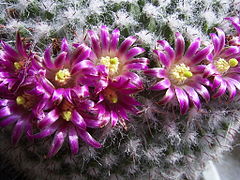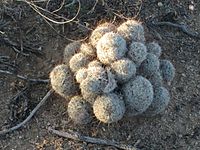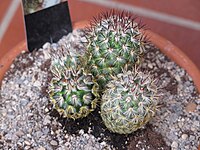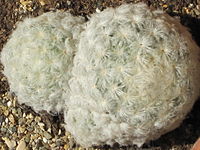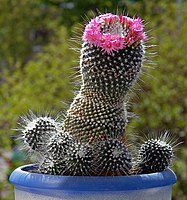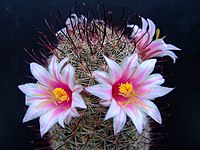
A cactus is a member of the plant family Cactaceae, a family comprising about 127 genera with some 1,750 known species of the order Caryophyllales. The word cactus derives, through Latin, from the Ancient Greek word κάκτος (káktos), a name originally used by Theophrastus for a spiny plant whose identity is now not certain. Cacti occur in a wide range of shapes and sizes. They are native to the Americas, ranging from Patagonia in the south to parts of western Canada in the north, with the exception of Rhipsalis baccifera, which is also found in Africa and Sri Lanka. Cacti are adapted to live in very dry environments, including the Atacama Desert, one of the driest places on Earth. Because of this, cacti show many adaptations to conserve water. For example, almost all cacti are succulents, meaning they have thickened, fleshy parts adapted to store water. Unlike many other succulents, the stem is the only part of most cacti where this vital process takes place. Most species of cacti have lost true leaves, retaining only spines, which are highly modified leaves. As well as defending against herbivores, spines help prevent water loss by reducing air flow close to the cactus and providing some shade. In the absence of true leaves, cacti's enlarged stems carry out photosynthesis.

Cochemiea is a genus of cactus. It has previously been synonymized with Mammillaria, but molecular phylogenetic studies have shown that when broadly circumscribed, Mammillaria is not monophyletic, and Cochemiea has been accepted as a separate genus. Cactaceae is the 5th most endangered plant or animal family globally evaluated by the International Union for the Conservation of Nature.

Pelecyphora, pincushion cactus or foxtail cactus is a genus of cacti, comprising 20 species.They originate from Mexico and the United States.

Oreocereus is a genus of cacti, known only from high altitudes of the Andes. Its name means "mountain cereus", formed from the Greek prefix oreo- and the Neo-Latin cereus, meaning wax or torch.

Fishhook cactus is a common name for any hook-spined species of the genera Mammillaria, Echinomastus, Sclerocactus, or Cochemiea. They are small cacti, usually growing up to 6-7 inches (20 cm) high, and are shaped similar to a barrel cactus. They are not to be confused with the fishhook barrel cactus of the Sonoran and Chihuahuan Deserts. The Fishhook cactus is a large category of around 150 species.

Cochemiea dioica, also called the strawberry cactus, California fishhook cactus, strawberry pincushion or fishhook cactus, is a cactus species of the genus Cochemiea. Its common name in Spanish is biznaga llavina. Temperature along with precipitation are consequential factors in distributing plant species.

Mammillaria zeilmanniana is a species of cactus. It is endemic to Mexico, where it is known only from Guanajuato. It grows in a narrow canyon usually near water where there is high humidity, its total population is fewer than 250 individuals. It is threatened by illegal collection for the horticultural trade. Recent studies link this species to Mammillaria crinita.

Pelecyphora vivipara is a species of cactus known by several common names, including spinystar, viviparous foxtail cactus, pincushion cactus and ball cactus. It is native to North America, where certain varieties can be found from Mexico to Canada. Most of these varieties are limited to the Mojave and Sonoran Deserts. The species epithet "vivipara" is due to the species' viviparous reproductive habit.
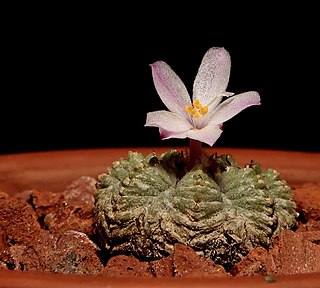
Aztekium ritteri is a species of cactus native to the Mexican state of Nuevo León.

Mammillaria rhodantha, the rainbow pincushion, is a plant in the cactus family (Cactaceae) and is one of 171 species in the genus Mammillaria which are characterized by having nipple-shaped tubercles or prominences on their surface.

Mammillaria spinosissima, also known as the spiny pincushion cactus, is a species of flowering plant in the cactus family Cactaceae, endemic to the central Mexican states of Guerrero and Morelos, where they grow at elevations of approximately 1,600 to 1,900 metres. The species was described in 1838 by James Forbes, gardener of the Duke of Bedford. Botanist David Hunt collected a specimen in 1971, when he located one near Sierra de Tepoztlan, Mexico.

Sclerocactus brevihamatus is a species of cactus known by the common name shorthook fishhook cactus.

Pelecyphora sneedii is a rare species of cactus known by the common names Sneed's pincushion cactus and carpet foxtail cactus. It is endemic to the Chihuahuan Desert of the southwestern United States and northwestern Mexico. It is a small, variable cactus with a lengthy taxonomic history, and is often subdivided into a number of subspecies or varieties. It is usually found on steep, rocky habitats, primarily of limestone geology, in desert scrub or coniferous forest. A species of conservation concern, P. sneedii faces threats from poaching, urban encroachment, and wildfires.

Rebutia minuscula is a species of cactus from South America found in northern Argentina and Bolivia. It is the type species of the genus Rebutia. As its synonym Rebutia senilis it has gained the Royal Horticultural Society's Award of Garden Merit. Its cultivars 'Krainziana', 'Marsoneri' and 'Violaciflora' are also listed as having gained the Award of Garden Merit.
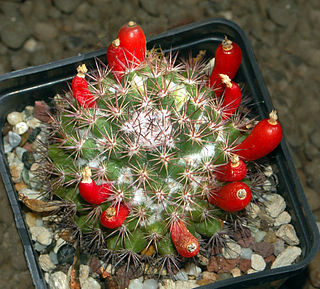
Mammillaria mammilllaris, common name woolly nipple cactus, is a species of plant in the family Cactaceae. It is the type species of the genus Mammillaria. It has been described by Carolus Linnaeus as Cactus mammillaris in 1753. The specific epithet mammillaris comes from the Latin mammilla, meaning nipple, with reference to the characteristic tubercles.

Mammillaria geminispina, the twin spined cactus, is a species of flowering plant in the family Cactaceae, native to central Mexico.

Mammillaria bocasana is a species of cactus in the subfamily Cactoideae. It is often sold as a "powder puff" cactus, and also as a "Powder Puff Pincushion." The plant is protected from collecting in the wild in Mexico.

Mammillaria fraileana is one of about 200 species of the genus Mammillaria from the cactus family Cactaceae. This species is native to Mexico and can be found along the east coast of the southern part of Baja California Peninsula in Desert Scrub communities. They tend to grow in non-calcareous dry granite-based soil but can also grow in rocky habitats, either in rock fissures or directly on top of the rock surface even without the presence of soil. Thus, the mineral composition of the rocks in their habitat directly influences their abundance. The habitat of Mammillaria fraileana is home to succulent flora and is particularly rich in local endemics. Currently, no major threats to the species are known to exist.

Pelecyphora macromeris, the nipple beehive cactus, is a species of cactus in the United States and Mexico. In the Chihuhuan Desert, it is common and has a wide range.

Pelecyphora alversonii commonly known as cushion foxtail cactus or cushion fox-tail cactus, is a species of flowering plant in the family Cactaceae, native to the southwestern United States.

